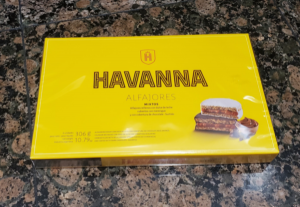
When I was 8 years old, my father began working for a baked goods company in Argentina. The baked goods company made every single treat my young little heart could ever dream of. In my young mind, my father was the equivalent of Willy Wonka.
He was hired by the company as a mold maker. The molds he made were used to make all of the baked goods. Per company rules, employees were allowed to indulge in any of the company’s products as long as they did so on the company’s premises. Employees were not allowed to take any of the goods home without purchasing them first. If employees were caught taking anything home, they would risk being dismissed from their job. My dad was so lucky to work there, I thought. When I was old enough, I was going to work for the same company.
My family’s financial situation was very dire when my father was hired. My family did not have any money to spare, especially to buy any sweet treats for me. My father knew how much I loved alfajores, so he would sneak out the sweet treats for me inside his clothes. Every day, at around 5pm, I would wait patiently for my dad to get home from work. I would search all over his clothes until I would find the hidden alfajores. It was our daily ritual until he sadly left the company to come to the United States.
What is an Alfajor?
An alfajor is a very popular sweet treat found in many South American countries. Contrary to the belief that the alfajor originated in South America, it actually originated in the Middle East sometime in the 19th century. According to dialectologists, the name alfajor is derived from the Arabic word al-fakher, which means luxurious.
Alfajores are made with two round cookies made of wheat flour or corn starch with different sweet fillings between them. The inside filling is usually dulce de leche and the outside is usually covered in glazed sugar (my personal favorite), coated with dark or white chocolate or shredded coconut. Argentina is the world’s largest consumer of alfajores. Alfajores are the most common snack that is eaten by both children and adults. Alfajores are also very popular in many other South American countries such as Uruguay, Chile and Peru.
Alfajores can be enjoyed at any time to curb hunger between meals or share with friends and loved ones. They can be paired with a variety of beverages and make a delicious dessert after any meal. Alfajores are one of the best gifts you can give friends and loved ones when traveling to the US from Argentina. At least, that is the best gift someone can bring me. As soon as I bite into a delicious alfajor, it transports me back to the days that I would wait for my father to come home from work so that I could search his pockets for my sweet treats.
 There are many well-known alfajor brands in South America. My personal favorite alfajor brand is Havanna. The brand Havanna was founded in 1948 by Benjamín Sisterna, Demetrio Elíades and Luis Sbaraglini in the city of Mar del Plata (a coastal city in Argentina).
There are many well-known alfajor brands in South America. My personal favorite alfajor brand is Havanna. The brand Havanna was founded in 1948 by Benjamín Sisterna, Demetrio Elíades and Luis Sbaraglini in the city of Mar del Plata (a coastal city in Argentina).
The Havanna alfajor is not a low-calorie food. The nutritional information of the alfajor is as follows:
Nutritional Facts
Serving Size 1 piece
Calories 205
Calories from fat 65
Total Fat 7g
Saturated Fat 3.9g
Trans Fat 0.1g
Cholesterol 12 mg
Sodium 34 mg
Total Carbohydrates 32 g
Dietary Fiber 0.2g
Sugars 17g
Protein 3.5 g

I loved the story about your father swiping the cookies for you.